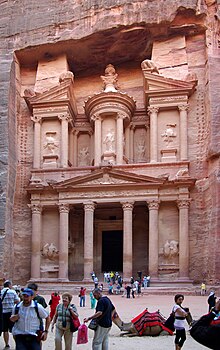Nabataean art

The Nabataean art originated in antiquity under the Nabataeans , a group of nomadic tribes in north-west Arabia (today mainly Jordan and Saudi Arabia ).
Art and architecture
Many remains of the Nabatean culture can be found to this day e.g. Sometimes under Roman ruins or in former cities and temples that are covered by sand and loess, with the temples partly to be found away from the cities. These have only been partially brought to light by excavations.
All temples uncovered so far had a courtyard ( temenos ) , which was usually bordered with circumferential colonnades . There were benches on three sides of the walls. The square floor plan of the Nabatean temples reveals Iranian influences on Nabatean art.
The Nabataean capital originally had smooth bosses and protruding "horns" at all corners. All walls were built in carefully processed ashlar masonry.
Examples of Nabataean art can be found in the temple ruins of Petra , Iram, Khirbet el-Tannur , Shia, and other sanctuaries , most of which were built around the time of Christ's birth . In addition, hundreds of rock tombs , the facades of which have been carved out of the sandstone , give an impression of Nabatean art. The crenellated and stepped tombs of Mada'in Salih are dominated by a high gate that forms a large part of the facade between pillars . In Petra, which was oriented to the west, the temple tombs were made from the 1st century BC. Chr. In the Graeco-Roman style built ( grave conditioning Al-Khazneh ). This led to archaeologists and art historians also evaluating Nabataean art as a plagiarism of Roman and Greek art. Only later was it recognized that it was a special characteristic of the artists of ancient Petra to create an independent art form from the Hellenic-Roman influences, which is now known as the Nabatean style .
In contrast, the images of gods in the sanctuary of Khirbet et-Tannur are close to the Parthian art of Hatras and Palmyra in their frontality and pictorial scheme . The relief of the Dushara temple in Si'a also clearly shows the influence of Parthian art.
See also
literature
- Theodor A. Busink: The Temple of Jerusalem. From Solomon to Herod. An archaeological-historical study taking into account the Western Semitic temple construction. Volume 2: From Ezekiel to Middot. Brill, Leiden 1980, ISBN 90-04-06047-2 , pp. 1252 ff. (Chapter XIV: Temples in Nabataea and Syria. ).
- Robert Wenning : The Nabatean Empire. Its archaeological and historical legacy. In: Hans-Peter Kuhnen : Palestine in Greco-Roman times. Beck, Munich 1990, ISBN 3-406-32876-8 , pp. 367-415 ( Handbuch der Archäologie. Vorderasien. 2, Vol. 2).
- Ehud Netzer : Nabataean architecture. In particular, tombs and temples. Antique world special tape. Mainz 2003. ISBN 3-8053-2913-X
